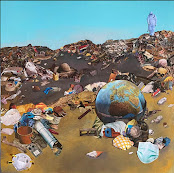DESMA 9 U9- Emilie Wouters

U9: Space + Art When I saw that this week’s theme was space and art, I immediately thought of astrophotography. I thought that was what the lecture was going to be about. Boy, was I wrong. What I love about this week is the variety of ways an art piece can interact with space. The guest speaker, Richelle Gribble, sent her work into space. Chelsey Bonestell does work depicting sci fi versions of space. Arthur Woods takes pictures of people dancing in space. Many photographers (including myself, though astrophotography isn’t exactly my main domain) and astrologists take pictures of space. Elena Soterakis Yoko Shimizu Richelle Gribble I want to come back to Richelle Gribble, because we cannot just glaze over the fact that she sent a work of art she made into outer space. The furthest my work has gone is out of the country, and even then it wa...



